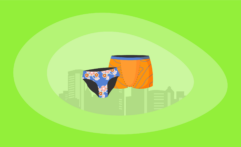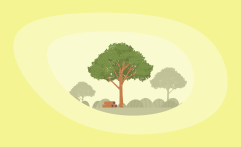10 Most Sustainable Canvas Clothing Brands: The Conscious Consumer’s Guide
Impactful Ninja is reader-supported. When you buy through links on our site, we may earn an affiliate commission.
Learn more
Learn more
.
Hey fellow impactful ninja ? You may have noticed that Impactful Ninja is all about providing helpful information to make a positive impact on the world and society. And that we love to link back to where we found all the information for each of our posts. Most of these links are informational-based for you to check out their primary sources with one click. But some of these links are so-called "affiliate links" to products that we recommend. First and foremost, because we believe that they add value to you. For example, when we wrote a post about the environmental impact of long showers, we came across an EPA recommendation to use WaterSense showerheads. So we linked to where you can find them. Or, for many of our posts, we also link to our favorite books on that topic so that you can get a much more holistic overview than one single blog post could provide. And when there is an affiliate program for these products, we sign up for it. For example, as Amazon Associates, we earn from qualifying purchases. First, and most importantly, we still only recommend products that we believe add value for you. When you buy something through one of our affiliate links, we may earn a small commission - but at no additional costs to you. And when you buy something through a link that is not an affiliate link, we won’t receive any commission but we’ll still be happy to have helped you. When we find products that we believe add value to you and the seller has an affiliate program, we sign up for it. When you buy something through one of our affiliate links, we may earn a small commission (at no extra costs to you). And at this point in time, all money is reinvested in sharing the most helpful content with you. This includes all operating costs for running this site and the content creation itself. You may have noticed by the way Impactful Ninja is operated that money is not the driving factor behind it. It is a passion project of mine and I love to share helpful information with you to make a positive impact on the world and society. However, it's a project in that I invest a lot of time and also quite some money. Eventually, my dream is to one day turn this passion project into my full-time job and provide even more helpful information. But that's still a long time to go. Stay impactful,Affiliate Disclosure
Why do we add these product links?
What do these affiliate links mean for you?
What do these affiliate links mean for us?
What does this mean for me personally?
![]()
Amid growing concerns about the textile industry’s environmental impact, there is pressure to find greener clothes for your wardrobe. Canvas and its durability make it a potentially sustainable textile material. Unfortunately, fashion greenwashing makes it harder for you and all other consumers to figure out which canvas clothing brands offer the most eco-friendly clothes. So, we had to ask: Which are the most sustainable canvas clothing brands?
The most sustainable canvas clothing brands include Patagonia, Eileen Fisher, and HYER GOODS, which use low-impact materials, employ full traceability, and strive for textile circularity. In addition, CARIUMA and Nothing New commit to reducing carbon footprints and chemical pollution.
Whether you are searching for a heavy-duty jacket, a bag, or a pair of sneakers to add to your wardrobe without negatively impacting the soil, the water, the animals, and other people, there is a brand for you. So, let’s keep reading to learn more about the most sustainable canvas clothing brands and how they ensure sustainable, ethical practices.
Here’s How Sustainable Canvas Fabrics Generally Are
Canvas fabrics are plain-woven, heavy-duty materials that can be made with various natural or synthetic fibers. The sustainability of canvas fabrics depends largely on the fibers used and the finishing practices—specifically whether or not synthetic coatings are applied.
“Sustainable: The ability to be maintained at a certain rate or level | Avoidance of the depletion of natural resources in order to maintain an ecological balance”
Oxford Dictionary
To understand the sustainability of canvas, we’ve assessed the life-cycle and each stage’s sustainability. This life-cycle assessment (LCA) is a method to evaluate the environmental impacts of products and materials. Here’s a quick summary of our LCA of canvas!
What makes sustainable canvas: The most sustainable canvas fabrics are made with plant fibers such as hemp, linen, or ramie sourced from fast-growing crops cultivated without pesticides. Organic cotton is also considered an eco-friendly material for making canvas fabrics.
Additionally: Using recycled plastics to make canvas fabrics helps reduce plastic waste and avoid further resource depletion, and, therefore, is considered sustainable.
Here’s How We Selected the Most Sustainable Canvas Clothing Brands
The brands on this list were chosen based on their commitment and actions to promote sustainable practices while reducing the environmental impacts of the textile industry.
They are transparent about their materials, processes, and workforce management within their supply chain.
Some brands focus their efforts on reducing waste and optimizing natural resources while others strive to reduce the carbon footprint of their clothes.
All of these brands share the commitment to reshape the textile industry toward a more sustainable and Earth-friendly sector.
These Are the 10 Most Sustainable Canvas Clothing Brands
Most Sustainable Canvas Clothing Brands
Overall, these canvas clothing brands are sustainable. Yet, they take various approaches to reduce environmental impacts and uphold ethical standards. Let’s dive into each brand and find out more.
Patagonia: Everyday Wear for Those Who Care
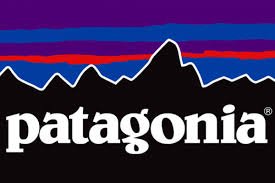
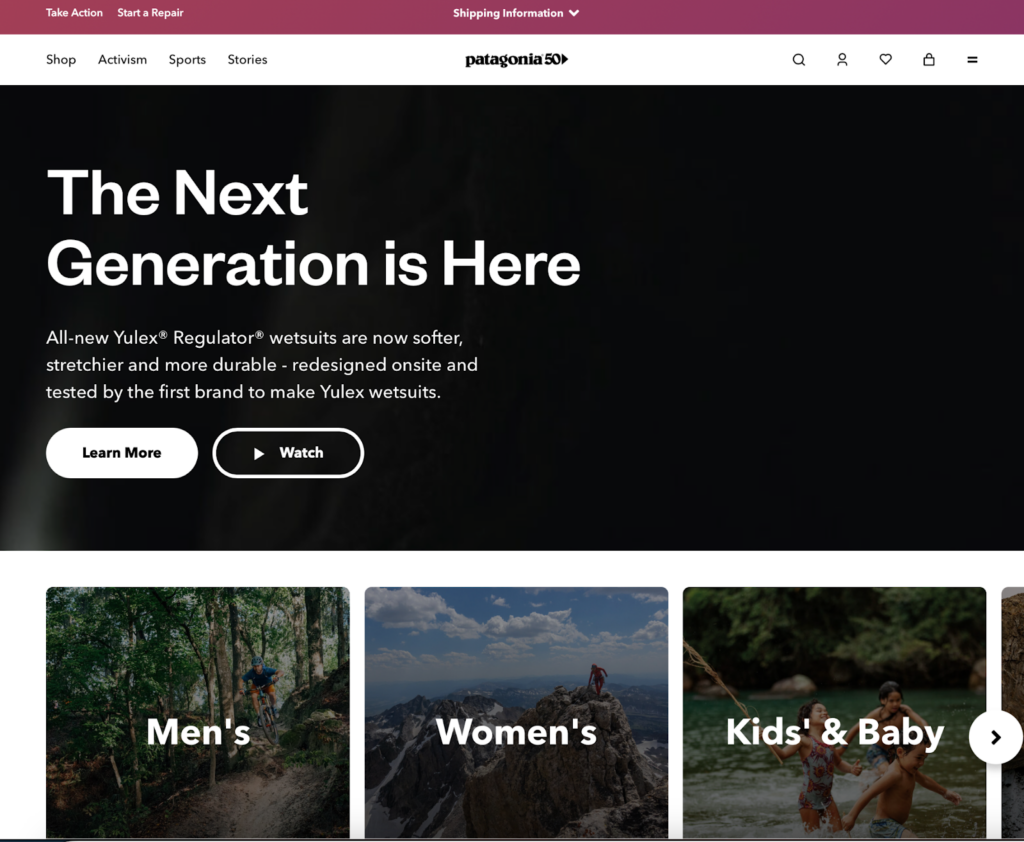
“Together, we can prioritize purpose over profit and protect this wondrous planet, our only home.”
Patagonia
🌎
How do they ensure their sustainability?
Patagonia puts sustainability at the center of their operation. They work to reduce, rather than simply offset, carbon emissions where it matters the most: in the supply chain and material manufacturing. They reduce their carbon footprint by removing high-impact virgin fossil-based fibers from their collections, using “Environmental Profit and Loss” to guide their production decision, and helping their suppliers to cut emissions. Patagonia’s fall 2023 collections are made up mostly of preferred materials (91% by fabric weight), including recycled cotton, regenerative organic cotton, hemp, and Man-Made Cellulose Fibers. Specifically, Patagonia’s canvas fabrics are plain-weave blends made with low-impact fibers (hemp, organic cotton, recycled polyester). On top of that, Patagonia’s Worn Wear Program encourages customers to repair and recycle their products, extending the textile lifecycle and reducing waste. Lastly, Patagonia is certified as a B Corporation and a Bluesign® brand.
🌐
How do they ensure their ethics?
Patagonia commits to fair trade practices. Through the partnership with Fair Trade USA, they currently produce 86% of their clothes in 20 Fair Trade Certified factories. Patagonia pays a premium for every item produced in such factories, accumulating in a fund for workers to use in their chosen community projects, whether in healthcare or parent support or to withdraw as a cash bonus. Additionally, they have various social responsibility programs to prevent harm and create positive impacts on the lives of apparel workers in their supply chain. These include the Fair Labor Association, the Living Wage Program, the Migrant Workers Program, and the Responsible Purchasing Practices. Patagonia is fully transparent about the locations of their facilities and suppliers.
🤝
Are they part of any giving-back programs?
Since 1985, Patagonia has pledged 1% of sales annually to environmental causes. They have awarded over $89 million in cash and kind donations to domestic and international grassroots environmental groups, making a difference in their local communities. In 2022, the founder of Patagonia gave away his family’s ownership of the company to the newly created Patagonia Purpose Trust and the not-for-profit organization Holdfast Collective, ensuring that all future profits from the company are used to fight the climate and extinction crisis.
🛍️
What is their product range?
- Best for: kidswear, menswear, womenswear
- Product range: shirts, pants, jackets, blazers, hoodies, sweatshirts, T-shirts, shorts, plus-size
- Price range: $$$
- Size range: XXS–XXXL
Eileen Fisher: A Sustainable Fashion Brand Focusing on Eco-Friendly Materials and Textile Circularity
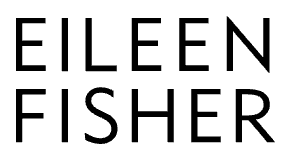
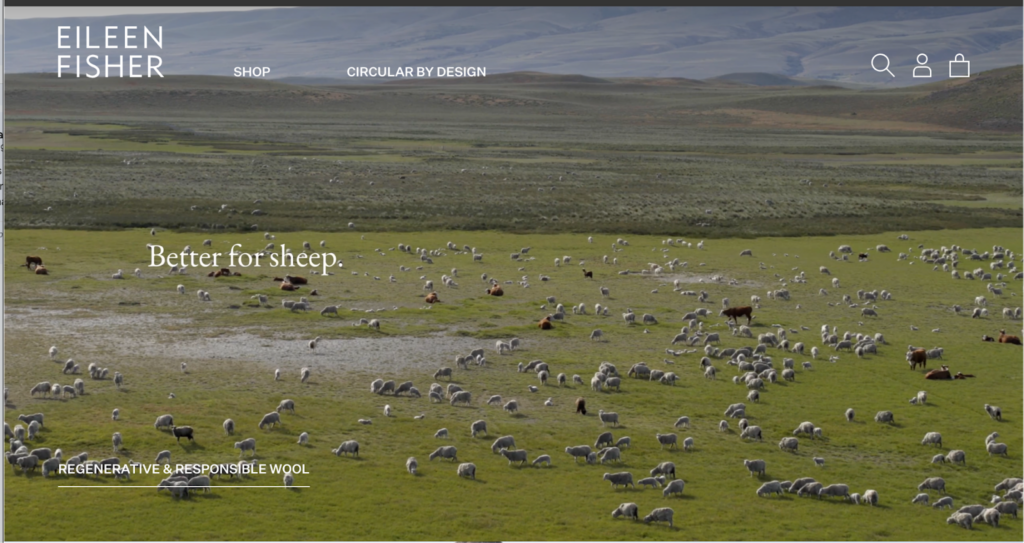
“The Biggest Thing We Can Do Is Reduce”
Eileen Fisher, founder of Eileen Fisher
🌎
How do they ensure their sustainability?
Eileen Fisher’s sustainability efforts focus on using eco-friendly materials, reducing greenhouse gas emissions generated from their operations and supply chain, reducing fabric and corporate waste, and recycling the brand’s used clothes back into new products. They use a medium proportion of low-impact natural fabrics, including organic cotton, linen, hemp, and blends of natural fibers like hemp-cotton canvas. Their commitments to sustainable materials, circular systems, and environmentally friendly practices are demonstrated in initiatives like VISION 2020, Horizon 2030, and Renew. They are certified as a B Corporation and a Bluesign® brand.
🌐
How do they ensure their ethics?
Eileen Fisher is committed to ethical practices. They have worker empowerment initiatives such as collective bargaining and the right to make a complaint. For example, their “Our Love, Peru” project supports over 450 families in and around Arequipa with higher fair trade wages and investments in the local community. Additionally, Their VISION 2020, set in 2015, tackled unethical labor practices.
🤝
Are they part of any giving-back programs?
Eileen Fisher supports many women-owned businesses. The brand has provided, since their inception, many grants for women, including the current program Supporting Women in Environmental Justice.
🛍️
What is their product range?
- Best for: elegant, classic, and casual women’s clothes
- Product range: dresses, blouses, sweaters, cardigans, pants, skirts and outerwear, shoes, accessories
- Price range: $$$
- Size range: XXS–3XL
HYER GOODS: Clothes and Accessories Made With Deadstock
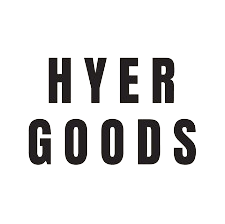

“By upcycling “trash” we eliminate the massive energy footprint needed to cultivate land, livestock, crops and fertilizers, while simultaneously reducing the amount of waste being sent to landfill. ”
HYER GOODS
🌎
How do they ensure their sustainability?
HYER GOODS ensures sustainability by rescuing yarns and fabrics abandoned by the fashion industry and turning them into beautiful clothing items and accessories. Their entire collection of bags, wallets, jackets, and beanies are crafted from deadstock, surplus, and leftovers, including luxury leftover leather, deadstock leather, locally sourced abandoned wool yarns, and deadstock canvas. The upcycled canvas collection is made with natural fibers (cotton and linen). Beyond reducing carbon emissions through diverting textile waste from landfills, HYER GOODS offsets 100% of their carbon emissions from shipping. They partner with EcoCart to support Global Sustainable Infrastructure Projects, investing in multiple sustainable infrastructure carbon offset projects, like wind and solar farms, biogas, and hydropower.
🌐
How do they ensure their ethics?
HYER GOODS traces most of their supply chain and audits their final stage of production.
🤝
Are they part of any giving-back programs?
HYER GOODS has pledged to donate 1% of net sales on their site to support organizations that foster the physical and mental well-being of people in need. Some of the previous recipients of their donations are the Malala Fund, WHO, No Kid Hungry, and The Okra Project.
🛍️
What is their product range?
- Best for: menswear, womenswear
- Product range: bags, wallets, blazers, beanies, scarves
- Price range: $$$
- Size range: XS–L
CARIUMA: Sneakers Designed for Style, Comfort, and Sustainability
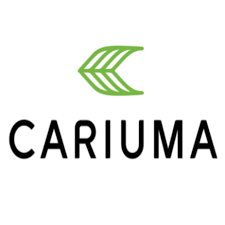
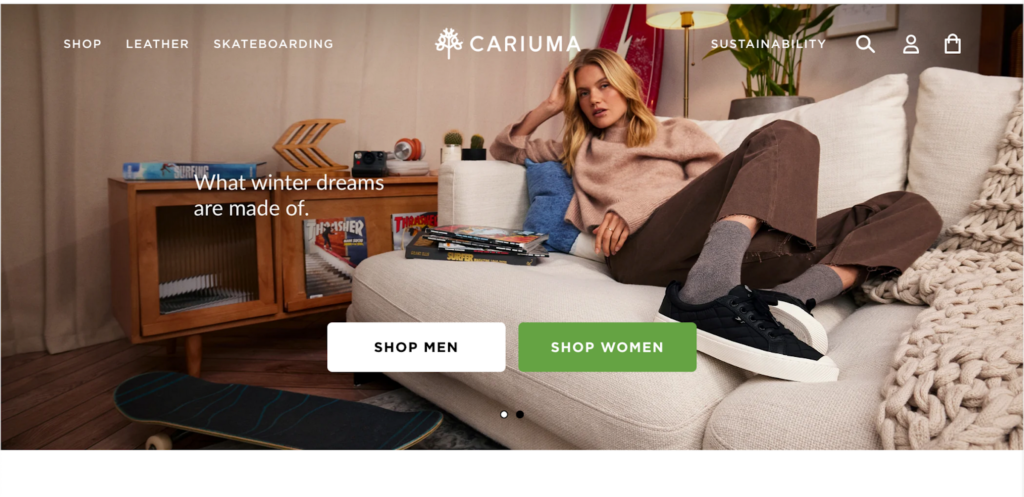
“We iterate a sneaker style for a year + before we bring it to production and we attempt to reduce the number of steps it takes to manufacture (which saves energy and time).”
CARIUMA
🌎
How do they ensure their sustainability?
CARIUMA prioritizes sustainability by increasing the natural content of their products. In particular, they prioritize materials that renew quickly, like bamboo and sugarcane, and plant-derived substances, such as cork and rubber, that can be harvested without cutting down trees. CARIUMA also sources lower-impact alternatives to conventional sneaker materials, for example, organic cotton instead of cotton, mamona oil, recycled nylon, and rPET (recycled PET—polyethylene terephthalate—plastic) to replace virgin plastics. For example, they offer various canvas sneakers made with organic cotton. Furthermore, they reduce their carbon footprint via a series of initiatives, including using solar energy, LED lighting, and a cooling tower in their warehouse, delivering sneakers in one recycled and recyclable paper box (which acts as both packaging and a shoe box), and opting for a carbon-neutral shipping option.
🌐
How do they ensure their ethics?
CARIUMA binds their suppliers to a Code of Conduct that covers all of the ILO’s Fundamental Freedoms Principles. They also trace most of their supply, specifically, 100% of Tier 1 suppliers—the footwear manufacturer, 85% of Tier 2 suppliers involving raw material processors, mills, knitting, packaging, outsole factory, and components in general, and 59% of their Tier 3 suppliers who provide yarns, polymers, and chips. Additionally, their manufacturing partner is audited annually by WRAP. They also visit their suppliers routinely. Regarding the use of animal skins in their leather sneakers, CARIUMA has an Animal Welfare Policy, ensuring animal welfare standards and transparency in the leather supply chain. Their leather suppliers are certified and audited by the Leather Working Group (LWG)
🤝
Are they part of any giving-back programs?
Since June 2020, CARIUMA has committed to planting two trees for every pair of sneakers they sell. Their reforestation program started in Brazil, with over 2 million trees planted. They work closely with the local indigenous communities, following their guidance on how to tend to the land and best support regrowth and restoration, improve seed storage efficiency, and go about replanting methods that mitigate risk and preserve biodiversity.
🛍️
What is their product range?
- Best for: womenswear, menswear
- Product range: sneakers
- Price range: $$
- Size range: XS–XL
Nothing New: Sneakers of Luxury Quality Built With Sustainable Materials

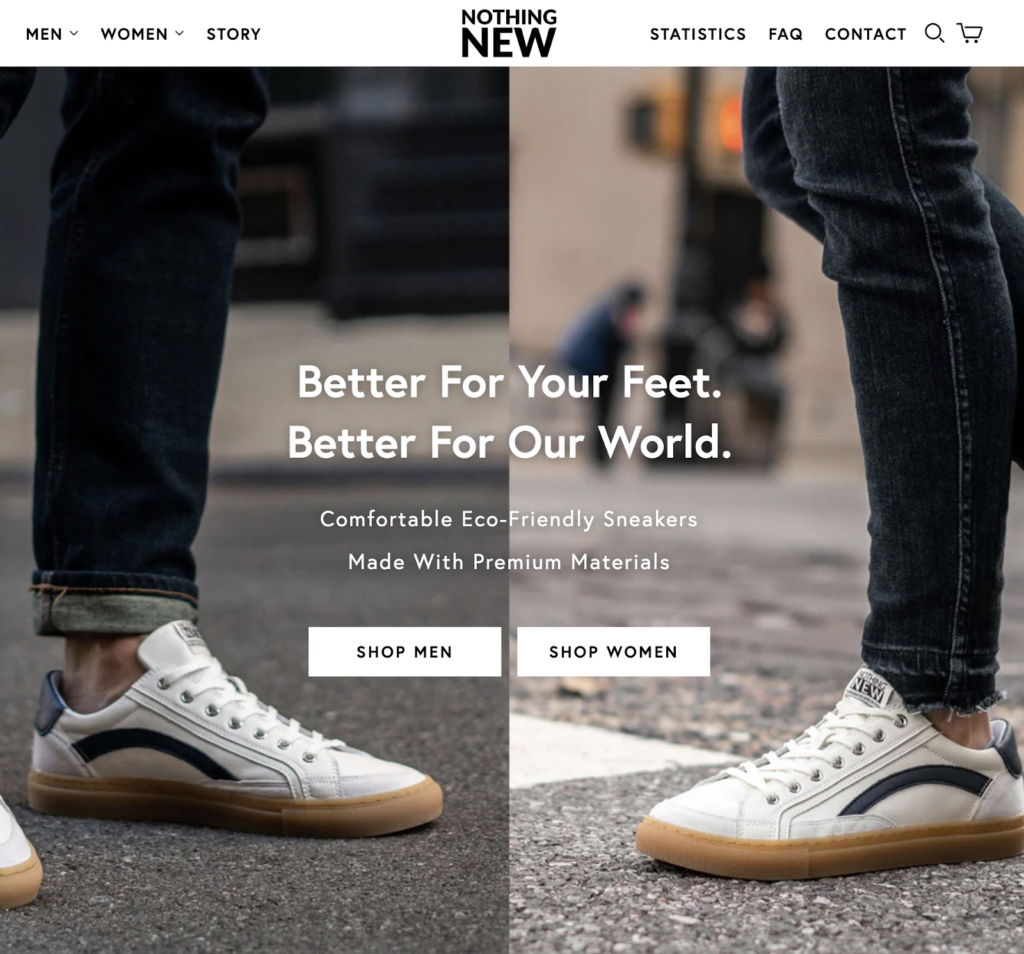
“By helping develop best-in-class sustainable products and investing in programs to minimize our environmental footprint, we hope to raise the bar for what customers expect from brands and contribute to the change we.”
Nothing New
🌎
How do they ensure their sustainability?
Nothing New ensures sustainability by lowering their carbon footprint. They achieve that firstly by prioritizing recycled materials to make their sneakers and packaging. Their Beyond CanvasTM is canvas material based entirely on post-consumer recycled plastic with Global Recycle Standard (GRS) certification, reverting on average 5.6 plastic water bottles away from landfills per pair of sneakers. Nothing New also rescues leather to make Beyond LeatherTM, another upper sneaker material certified by GRS. The suede leather used in some of their shoes is manufactured chrome-free by a tannery with a gold standard from the Leather Working Group. Further down the life-cycle in the manufacturing stage, Nothing New reduces their environmental impacts by avoiding cement and vulcanized construction of the shoes, which involves chemical-based glues and sulfur emissions. Instead, they opt for stitch construction, creating a more flexible and durable bond between the outsole and upper, extending the shoes’ lifespan. Beyond making long-lasting products, Nothing New also runs the Virtuous Circle Program, encouraging consumers to send in pre-loved shoes to be donated or disassembled for material recycling. Lastly, Nothing New offsets all their emissions in projects expanding forests that capture and store carbon, generating wind energy, and replacing fossil fuels with biofuels.
🌐
How do they ensure their ethics?
Nothing New partly traces their supply chain, including the final stage of production, as well as some of the second stage.
🤝
Are they part of any giving-back programs?
Nothing New donates used shoes.
🛍️
What is their product range?
- Best for: menswear, womenswear
- Product range: low-top sneakers, high-top sneakers, socks, accessories
- Price range: $$
- Size range: XS–XXL
VEJA: Sneakers Made With Innovative, Low-Impact Materials
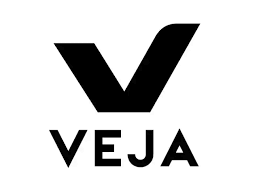

“VEJA is walking on two feet: ecology and social justice on one side, design on the other. We never compromise between the both of them.”
Sebastien Kopp, Co-Founder of VEJA
🌎
How do they ensure their sustainability?
VEJA ensures sustainability by opting for a high proportion of low-impact materials and reducing textile waste. In 2020, recycled polyester and organic cotton made up nearly 76% of their sneaker materials. They also use other eco-friendly materials, including organic jute and recycled cotton. With leather, the traditional shoe material, VEJA strives to improve traceability and transparency. All their tanning partners are Gold certified by the Leather Working Group which promotes sustainable environmental practices in the leather industry. As a vegan alternative to leather, they use canvas based on organic cotton and regenerative cotton coated with a 54% bio-based coating. VEJA discloses the total carbon emissions released throughout their supply chain and the equivalent carbon footprint of various models. By working out the proportion of their emissions, they identify the hot spots and reduce their footprints in multiple ways, including using renewable energy, improving the most-polluting products (leather-based sneakers), reducing air freight for transportation from factories to retailers, and taking the train as the main transporting methods for team members. In June 2020, they launched project VEJA x Darwin, a test hub for cleaning, repairing, and recycling old sneakers, keeping materials longer in circulation while reducing waste and carbon footprint.
🌐
How do they ensure their ethics?
Fair trade is one of the three fundamental pillars VEJA is built on. They work directly with producers and use annual contracts to guarantee income and a reasonable price for producers. Workers who manufacture VEJA sneakers are well compensated and live in normal conditions. Their Supplier Code of Conduct covers the ILO’s Four Fundamental Freedoms principles. VEJA also traces most of their supply chain and visits their suppliers regularly.
🤝
Are they part of any giving-back programs?
VEJA partners with Log’ins (Logistics & Insertion), an organization that employs people with light disabilities and promotes their social inclusion. In 2022, more than 200 employees recognized as disabled workers were supported by Log’ins.
🛍️
What is their product range?
- Best for: womenswear, menswear, childrenswear
- Product range: sneakers
- Price range: $$
- Size range: XS–XXL
Collectie Canvas: Canvas Sneakers Made With Natural, Low-Impact Materials

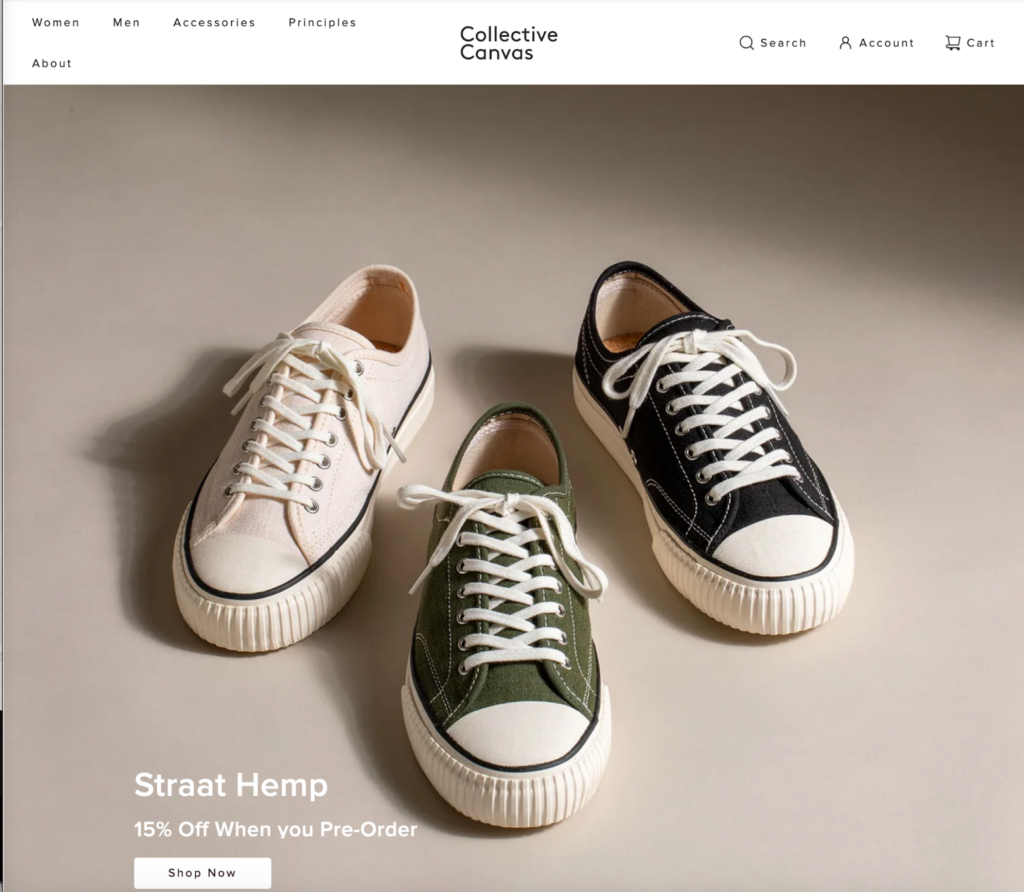
“Our intention is that through the responsible use of natural materials, the bulk of our shoes are biodegradable at the end of their life.”
Collectie Canvas
🌎
How do they ensure their sustainability?
Collectie Canvas ensures sustainability by sourcing natural materials for shoes and shoe boxes. 97% of the composition of their footwear products comes from nature, including organic hemp, organic cotton, natural latex rubber, and renewable castor oil. For example, their Straat Hemp Black/White sneakers have the upper made from organic hemp canvas, the lining made from a blend of hemp and organic cotton, an insole made with renewable caster oil and naturally sustainable cork veneer, and laces made with organic cotton. Regarding packaging, their shoe boxes and courier bags are made from 100% post-consumer paper waste and printed from plant-based inks. Furthermore, Collective Canvas has a Takeback & Recycling Scheme, offering customers a responsible way of recycling used sneakers. Specifically, the organic cotton canvas uppers and laces are recycled in Little Yellow Bird’s Circular Cotton initiative to create new yarns for textile production. On the other hand, the natural rubber soles and upper reinforcements are ground into rubber crumbs and then repurposed into roading asphalt, equestrian arenas, and artificial sports turf. Similarly, the insoles and eyelets are given new life rather than sent to landfills.
🌐
How do they ensure their ethics?
Collectie Canvas is transparent about where their products are made. All workers are paid a living wage, which includes health insurance and pension contributions. The workers are also provided daily meals, on-site lodging, as well as the option of free English classes. They visit their manufacturer in China several times a year. Collectie Canvas is also transparent about their prices, broken down by the core components of their footwear products.
🤝
Are they part of any giving-back programs?
Collectie Canvas sells all of their b-stock or less-than-perfect pairs as Imperfects and gives 100% of the proceeds to the Mental Health Foundation of New Zealand.
🛍️
What is their product range?
- Best for: menswear, womenswear
- Product range: sneakers, accessories
- Price range: $$$
- Size range: XS–XL
Ethletic: Traceable Sneakers Made With Natural and Recycled Materials
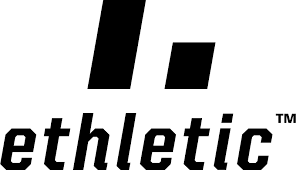
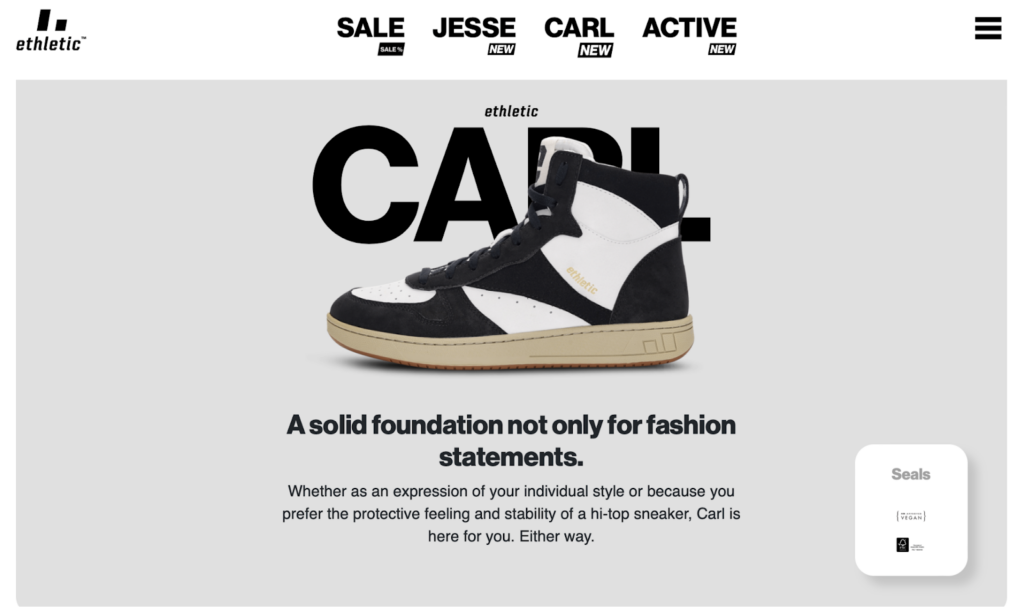
“The people who work for Ethletic aren’t numbers on a balance sheet or a cost factor for us. We know these people. We appreciate them and their skills, their commitment, their history.”
Ethletic
🌎
How do they ensure their sustainability?
Ethletic promotes sustainability by using a high proportion of eco-friendly materials. Specifically, for their signature shoes, they source canvas based on Fairtrade organic cotton for the uppers and FSC-certified rubber for the soles. Additionally, Ethletic uses GRS-certified recycled PU leather in some models to achieve high comfort and guaranteed perfect fit. Further down the life-cycle in the manufacturing stage, Ethletic shoes are built in a way that allows future separation and recycling, a first step toward going circular. Regarding transportation, Ethletic commits to “no air shipment,” transporting all their sneakers exclusively by ships. Since 2019, they have offered their customers a discounted repair option in collaboration with Berlin-based start-up Sneaker Rescue, helping to extend the lifespan of the sneakers and reduce pressure on the environment.
🌐
How do they ensure their ethics?
Ethics is at the center of Ethletic’s operation. Their manufacturing partner is Fairtrade-certified and has a premium-funded worker society, ensuring the workers’ fair working conditions and treatment. Specifically, for each pair of shoes sold, one US dollar is paid as a premium to the Talon Fair Trade Workers Welfare Society. A democratically elected group then decides which health care and educational projects to use this money for. Ethletic also traces the whole supply chain and audits most of their suppliers. They disclose the workers who make their products and enable visitors to tip these workers directly on their website. Additionally, Ethletic commits to product traceability, including the total distance traveled from fabric to brand and the material composition.
🤝
Are they part of any giving-back programs?
Ethletic is not known to be part of any giving-back programs.
🛍️
What is their product range?
- Best for: menswear, womenswear
- Product range: sneakers
- Price range: $$
- Size range: XS–XL
Komodo: An Ethical Brand Since 1988


“We are passionate about protecting and nurturing our planet, but we also love fashion and don’t believe the two need to be mutually exclusive.”
Komodo
🌎
How do they ensure their sustainability?
Komodo ensures sustainability by sourcing eco-friendly materials for their clothing items and using renewable energy for their production. Firstly, they use a medium proportion of eco-friendly materials, including organic cotton certified by the Global Organic Textile Standard (GOTS), linen, hemp, TENCELTM, and recycled polyester. Specifically, organic cotton is also the base of the canvas fabrics used in some clothes, bags, and shoes in their collection. Regarding packaging material, Komono no longer has single use plastic in their supply chain, a commitment they decided on in 2019. Further down the life-cycle in the manufacturing stage, they use renewable energy to reduce their climate impact. Lastly, they partner with OMNI to facilitate the selling and buying of Komodo’s pre-loved items, striving toward circulating clothes and reducing waste.
🌐
How do they ensure their ethics?
Komodo has a Code of Conduct that covers all of the ILO’s Fundamental Principles and Rights at Work. They trace most of their supply chain and visit their suppliers regularly. Additionally, the majority of factories they use are audited according to GOTS or SEDEX.
🤝
Are they part of any giving-back programs?
As a member of 1% for the Planet, Komono commits to donating one percent of their sales to the Sumatran Orangutan Society, which is restoring natural rainforests and ecosystems through purchasing and repurposing palm oil plantations. They have also donated to various charities and social projects, including, but not limited to, Tibet Relief Fund, Sunrise Orphanage Kathmandu, Water for Africa, and Inspirasia Foundation.
🛍️
What is their product range?
- Best for: womenswear, menswear
- Product range: tops, T-shirts, shirts, dresses, sweaters, coats, jackets, jumpsuits, dungarees, skirts, denim, pajamas, socks, shoes, bags, accessories
- Price range: $$
- Size range: S–XL
Orba: “Comfort-Without-Compromise” Shoes


“We make shoes that are good for the people and good for the planet without compromising comfort and quality.”
Orba
🌎
How do they ensure their sustainability?
Orba ensures their sustainability by designing and making shoes that are biodegradable. They achieve this by sourcing natural materials for all compositions of their shoes. Specifically, their sneakers don’t use a high-polluting leather upper, but a canvas upper made of linen, hemp, and ramie from renewable organic, rainfed crops. Orba was the first brand in the world to combine three of the most sustainable plant fibers in their upper. Additionally, they use soles made of natural rubber, rice husk ash, coconut oil, and beeswax, and footbeds that consist of cork, coconut husk, agave sisal, and latex. The materials for laces and threads are GOTS-certified organic cotton. Lastly, Orba has their shoes and materials go through 40 different tests to ensure that there are no traces of hidden pollutants; therefore, the shoes can go safely back to the earth at the end of their life.
🌐
How do they ensure their ethics?
Orba binds their suppliers with an Orba Supplier Code of Conduct, ensuring social equity and fair treatment in their factories. Their Tier 1 supplier meets the Business Social Compliance Initiative Code of Conduct (BSCI). Additionally, they fund training programs to achieve sustainable growth and a pathway for their smaller suppliers to comply with BSCI in the future.
🤝
Are they part of any giving-back programs?
Orba is not known to be part of any giving-back programs.
🛍️
What is their product range?
- Best for: menswear, womenswear
- Product range: sneakers
- Price range: $$$
- Size range: XS–XL
Canvas Fabrics: Durable Materials for Heavy-Used Clothing Items
Canvas is a plain-woven, heavy-duty material originally made with hemp or linen fibers. Modern canvas fabrics are often made with cotton and, depending on their specific functions, treated with synthetic substances.
Here are the life-cycle stages of canvas fabrics and each stage’s sustainability assessment:
- Sourcing for canvas fabrics: Sourcing conventional cotton fiber—the common raw material for modern-day canvas fabrics—is unsustainable. The cotton crop is water-thirsty and vulnerable to various pests. Also, the widespread monoculture in cotton cultivation depletes the soil and necessitates synthetic fertilizer in many growing regions. However, the sourcing stage of canvas fabrics can be sustainable when raw materials come from recycled waste, organically farmed, and/or low-input plants. For example, sustainably sourced raw materials for canvas fabrics include things like discarded cotton fibers (recycled cotton), organically-grown flax plants (organic linen), or low-input and high-yield industrial hemp plants (hemp).
- Manufacturing of canvas fabrics: Manufacturing canvas fabrics is generally unsustainable. Regardless of the base fibers, the fundamentally mechanical processes of manufacturing canvas fabrics demand a lot of energy. The finishing processes and their environmental impacts vary depending on the desired physical properties to match the different purposes of using canvas fabrics.
- Transportation of organic canvas fabrics: Canvas fabrics typically travel from fields (plant-based virgin canvas) or collection hubs (recycled canvas) to factories, then sorting centers, shops, and consumers’ homes before going to recycling centers or landfills. The GHG emissions associated with transporting vehicles could be significant.
- Usage of canvas fabrics: Using canvas fabrics is generally sustainable. This heavy-duty material is durable and likely to last for a long time before needing replacement. Canvas fabrics are often used for products like handbags and shoes, which don’t require frequent washing, thus saving water and energy.
- End-of-life of organic canvas fabrics: The end-of-life stage for canvas fabric is generally sustainable, so long as it is made with 100% natural fibers, because then it is reusable, biodegradable, and compostable.
The sustainability of canvas fabrics depends largely on the natural fibers used and the finishing practices—specifically whether or not synthetic coatings are applied. The most sustainable canvas fabrics are made with easily renewable, organic plant fibers like organic hemp and organic linen.
Why Is It Important to Buy Products Made of More Sustainable Fabrics
It is important to buy products made of more sustainable fabrics because a sustainable textile industry has a lower carbon footprint, helps save natural resources, and is ultimately better for forests, animals, and humans.
Buying Sustainable Fabrics Reduces Your Carbon Footprint
The production of clothing and footwear is estimated to contribute 10% of global greenhouse gas emissions—more than all international flights and shipping combined. If the fashion industry were a country, it would be the fourth largest emitter of carbon dioxide.
One way to reduce the carbon footprint of the clothes you buy is to opt for sustainable fabrics. Sustainable fabrics, which are often made with natural or recycled fibers, have relatively low carbon footprints compared to petroleum-based fabrics. For example, organic cotton made in the US has a carbon footprint of 2.35 kg CO2 (per ton of spun fiber)—a quarter of polyester’s carbon footprint.
Buying Sustainable Fabrics Reduces Demand For Natural Resources and Waste Management
The textile industry uses water and land to grow cotton and other fibers. It is estimated that 79 billion cubic meters of water were used for the sector worldwide in 2015. For example, producing a single cotton t-shirt requires as much water as one person drinks for 2.5 years (2,700 liters of fresh water).
Worse yet, the textile economy is vastly more linear than circular: the largest amount of resources used in clothes ended up in landfills (instead of being recycled to remake clothes). According to a report by the Ellen MacArthur Foundation,
- Less than 3% of materials used in the textile economy in 2015 came from recycled sources.
- In other words, more than 97% of resources used in making clothes are newly extracted.
When clothing items are disposed of within a short period of time—under a year in the case of half of the fast fashion clothes—the natural systems that provide raw materials for fabrics don’t have enough time to recover and regenerate, which could lead to ecological breakdown.
Sustainable fabrics are made with less water and emissions while lasting longer:
- Because they are durable, you don’t need to buy new clothes too often.
- Thus, you help reduce the pressure to extract more resources for making new items.
Similarly, making and consuming sustainable fabrics made with recycled materials reduces the demand for virgin materials while helping tackle waste management.
Buying Sustainable Fabrics Encourages Sustainable Management of Forests
Sustainable plant-based fabrics are made with raw materials from forests and plantations that are sustainably managed, such as complying with FSC standards.
When you buy sustainable plant-based fabrics, you discourage unsustainable forestry practices like illegal logging. You can help reduce deforestation, biodiversity loss, and the effects of climate change.
Buying Sustainable Fabrics Encourages Fairer Treatment of Animals
The fashion industry is rife with animal mistreatment when it comes to making animal-based fabrics like wool or silk. Every year, billions of animals suffer and die for clothing and accessories.
Buying sustainable vegan alternatives can help to reduce the pressure on raising more and more animals to meet the demand for animal-based fabrics while sacrificing their well-being and lives.
Suppose you have to buy fabrics made with, for example, wool or silk; make sure you only choose brands committed to cruelty-free products. In that case, you help advocate better treatments for animals raised within the textile industry.
Using Sustainable Fabrics Encourages Fairer Treatment of Textile Workers
Recent statistics from UNICEF estimated as many as 170 million child laborers worldwide, many of whom were engaged in some form of work in the textile industry. They don’t get paid minimum wages and often work long hours.
When you buy sustainable fabrics from brands transparent about the working conditions at their factories, you discourage the use of child labor and help promote better working conditions for textile workers.
How Can You Generally Buy More Sustainable Fabrics
The key to sustainably buying fabrics is to check on relevant environmental and original certifications.
For natural fabrics:
- Global Organic Textile Standard (GOTS): A globally recognized certification system that ensures a certain threshold of organic content has been met. It covers manufacturing, packaging, labeling, transportation, and distribution (but not what happens in the fields where crops are grown).
- USDA Certified Biobased Product: The USDA BioPreferred® Certification is a voluntary certification offered by the United States Department of Agriculture. The certification identifies products made from plants or other renewable materials.
- Ecolabel: Ecolabel is the official European Union voluntary label recognized worldwide for certified products with a guaranteed, independently verified low environmental impact. The label requires high environmental standards throughout the entire life-cycle: from raw material extraction through production and distribution to disposal. It also encourages companies to develop innovative, durable, easy-to-repair, and recyclable products.
For plant-based semi-natural/semi-synthetic fabrics:
- Forest Stewardship Council: An FSC certification ensures that the wood (or wood-like material) comes from responsibly managed forests that provide environmental, social, and economic benefits.
There are two types of FSC Certification:- FSC Forest Management Certification, with a focus on the origin of the wood—the forest.
- FSC Chain of Custody Certification, which focuses on the path from the forest to the customer’s home.
- Program for Endorsement of Forest Certification: PEFC’s approaches to sustainable forest management are in line with protecting the forests globally and locally and making the certificate work for everyone. Getting a PEFC certification is strict enough to ensure the sustainable management of a forest is socially just, ecologically sound, and economically viable but attainable not only by big but small forest owners.
For recycled fabrics:
- Recycled Claim Standard (RCS): The Textile Exchange RCS was originally developed as an international, voluntary standard that sets requirements for third-party certification of Recycled input and chain of custody.
- The Global Recycled Standard (GRS): The Global Recycled Standard (GRS) is an international, voluntary, full product standard that sets requirements for third-party certification of Recycled Content, chain of custody, social and environmental practices, and chemical restrictions. It can be used for any product with more than 20% recycled material.
For all types of fabrics:
- STeP by OEKO-TEX®: STeP by OEKO-TEX® is an independent certification system for brands, retailers, and manufacturers from the textile and leather industry. It communicates organizational environmental measures, including reducing carbon footprint and water usage.
- OEKO-TEX® Standard 100: OEKO-TEX® labels aim to ensure that products pose no risk to human health (i.e., containing banned chemicals).
Some certifications that are signaling brands’ efforts toward lowered environmental impacts and a circular economy are:
- B Corp Certification: The label B Corp is a certification reserved for for-profit companies. Certified holders are assessed on their social and environmental impacts.
- Cradle2Cradle certification: Cradle2Cradle provides a standardized approach to material circularity. It assesses whether products have been suitably designed and made with the circular economy in mind covering five critical categories: material health, material reuse, renewable energy and carbon management, water stewardship, and social fairness.
Final Thoughts
Traditional hemp-based and linen-based canvas fabrics are generally sustainable, while the same cannot really be said for canvas fabrics made with conventional cotton fibers and PVC coating or synthetic fibers. The sustainability of plant-based canvas fabrics depends largely on the cultivation of the fiber crop, be it cotton, flax, or industrial hemp. If synthetic coating and dyes are not used in making canvas, the end products are biodegradable and can be more easily recycled.
By purchasing new or pre-loved canvas clothing items from brands that commit to sustainability, you support their mission to create a fairer and less harmful textile industry for all lives on Earth.
Here is the list (again) of the most sustainable canvas clothing brands:
- Patagonia
- Eileen Fisher
- HYER GOODS
- CARIUMA
- Nothing New
- VEJA
- Collectie Canvas
- Ethletic
- Komodo
- Orba
To make your use of these fabrics even more sustainable, follow these steps:
- Buy second-hand, recycled, or upcycled clothes made with canvas clothes.
- While using linen clothes, maximize the number of wears between washes and keep them as long as possible.
- At the end-of-life of your canvas clothes, upcycle the materials to extend their usage and arrange for them to be recycled or properly disposed of.
Stay impactful,

Sources
- Impactful Ninja: How Sustainable Are Canvas Fabrics? A Life-Cycle Analysis
- Science Direct: Life-cycle assessment (LCA)
- Impactful Ninja: How Sustainable Are Hemp Fabrics? A Life-Cycle Analysis
- Impactful Ninja: How Sustainable Are Linen Fabrics? A Life-Cycle Analysis
- Impactful Ninja: How Sustainable Are Ramie Fabrics? A Life-Cycle Analysis
- Impactful Ninja: How Sustainable Are Organic Cotton Fabrics? A Life-Cycle Analysis
- Patagonia: Home
- Eileen Fisher: Home
- HYER GOODS: Home
- CARUMIA: Home
- Nothing New: Home
- VEJA: Home
- Collectie Canvas : Home
- Ethletic: Home
- Komodo: Home
- Orba: Home
- Beaumont Organic: Home
- Thought: Home
- Patagonia: The Climate Crisis Is Our Business
- Patagonia: The Climate Crisis Is Our Business | No More Virgin Petroleum Fibers by 2025
- Patagonia: The Climate Crisis Is Our Business | Is Each Product Worth the Environmental Cost?
- Patagonia: The Climate Crisis Is Our Business | Help Suppliers Cut Emissions
- Patagonia: Environmental Responsibility
- Patagonia: Recycled Cotton
- Patagonia: Regenerative Organic Certified Fibers
- Patagonia: Hemp
- Patagonia: Man-Made Cellulose Fibers
- Impactful Ninja: How Sustainable Are Recycled Polyester Fabrics? A Life-Cycle Analysis
- Patagonia: WORN WEAR
- B Corporation: Patagonia
- Bluesign: Home
- Fair Trade: Home
- FAIR TRADE CERTIFIED: Improving Lives, Protecting the Planet.
- Patagonia: Social Responsibility
- Patagonia: Fair Trade
- Patagonia: Fair Labor Association
- Patagonia: Living Wage Program
- Patagonia: Migrant Workers Program
- Patagonia: Responsible Purchasing Practices
- Patagonia: Where We Do Business
- Patagonia: 1% for the Planet
- Forbes: Yvon Chouinard And The Patagonia Purpose Trust— What Is It And Will It Work?
- Fast Company: Patagonia uses capitalism to save the planet with the Holdfast Collective
- The New York Times: Patagonia Founder Gives Away the Company to Fight Climate Change
- Good On You: Brand Directory | Eileen Fisher
- Impactful Ninja: How Sustainable Are Natural Fabrics? A Life-Cycle Analysis
- Eileen Fisher: OUR VISION2020 RESULTS
- Eileen Fisher: Our Brand
- B Corporation: Eileen Fisher
- Bluesign: Home
- Eileen Fisher: Community | Love, Peru. Our Fair Trade Project.
- CFDA: HOW EILEEN FISHER IS THE ULTIMATE SUSTAINABLE LABEL
- Seek Capital: 11 Small Business Grants For Women
- Good On You: Brand Directory | VEJA
- HYER GOODS: Our Materials
- HYER GOODS: Luxury Leftovers
- HYER GOODS: Deadstock Leather Collection
- Impactful Ninja: How Sustainable Are Wool Fabrics? A Life-Cycle Analysis
- HYER GOODS: The canvas collection
- HYER GOODS: Carbon Neutrality
- Good On You: Brand Directory | HYER GOODS
- HYER GOODS: Our Monthly Mission
- Malala Fund: Home
- WHO: Home
- No Kid Hungry: Home
- The Okra Project: Home
- B Corporation: CARIUMA
- CARIUMA: EMPOWERING SUSTAINABLE CHOICES | Materials
- Impactful Ninja: How Sustainable Are Recycled Nylon ? A Life-Cycle Analysis
- CARIUMA: EMPOWERING SUSTAINABLE CHOICES | Operations
- CARIUMA: EMPOWERING SUSTAINABLE CHOICES | Factories
- CARIUMA: Code of Conduct
- Good On You: Brand Directory | CARIUMA
- CARIUMA: Leather sneakers
- CARIUMA: Animal Welfare Policy
- Leather Working Group: Home
- CARIUMA: REFORESTATION PROGRAM
- Nothing New: Carbon Neutral Commitment
- Textile Exchange: Global Recycle Standard
- Nothing New: Carbon Neutral Commitment
- Nothing New: Our Materials
- Impactful Ninja: How Sustainable Are Leather Fabrics? A Life-Cycle Analysis
- Nothing New: Virtuous Circle Program
- Good On You: Brand Directory | Nothing New
- Impactful Ninja: How Sustainable Are Jute Fabrics? A Life-Cycle Analysis
- Impactful Ninja: How Sustainable Are Recycled Cotton Fabrics? A Life-Cycle Analysis
- VEJA: Leather
- Pebble Magazine: Sustainable Shoes: 13 Brands Creating Planet-Friendly Footwear
- VEJA: The blindness around CO₂ emissions
- VEJA: Limits
- VEJA: Fair trade
- VEJA: Production
- Good On You: Brand Directory | VEJA
- VEJA: Reintegration
- Collectie Canvas: Principles
- Impactful Ninja: How Sustainable Are Organic Hemp Fabrics? A Life-Cycle Analysis
- Collectie Canvas: End of Life Recycling
- B Corporation: In full flight – Little Yellow Bird is changing the game from farm to factory
- Collectie Canvas: Imperfects
- Fair & Good: Brands We Love | Collectie Canvas
- Mental Health Foundation: Home
- Good On You: Brand Directory | Ethletic
- Fairtrade: Home
- Forest Stewardship Council: Home
- Impactful Ninja: How Sustainable Are Polyurethane (PU) Fabrics? A Life-Cycle Analysis
- Ethletic: SUSTAINABILITY
- Ethletic: Ethletic Story
- Sneaker Rescue: Home
- Fairtrade: Fairtrade Premium preview
- Ethletic: Fair For All
- Tracycle: Ethletic
- Good On You: Brand Directory | Komodo
- Global Organic Textile Standard: Home
- Impactful Ninja: How Sustainable Are TENCEL™ Fabrics? A Life-Cycle Analysis
- Komodo: Sustainability
- OWNI: Komodo
- Komodo: Code of Conduct
- International Labour Organization: ILO Declaration on Fundamental Principles and Rights at Work
- Komodo: Our Suppliers
- Sedex Members Ethical Trade Audit: Home
- 1% for the Planet: Home
- Komodo: Our Projects
- Komodo: Quick guide: Komodo’s journey towards zero plastic
- Tibet Relief Fund: Home
- Water For Africa: Home
- Inspirasia Foundation: Home
- B Corporation: Orba Shoes
- Orba: Orba Sustainability Framework 2022
- Orba: The A-Z of ways we go beyond.
- Orba: Materials
- Orba: Orba Supplier Code of Conduct
- AMFORI: Is BSCI a certificate, a label or a standard?
- Orba: Sustainability
- Impactful Ninja: How Sustainable Are Cotton Fabrics? A Life-Cycle Analysis
- Impactful Ninja: How Sustainable Are Organic Linen Fabrics? A Life-Cycle Analysis
- European Parliament: The impact of textile production and waste on the environment (infographic)
- Science Direct: The challenge of “Depeche Mode” in the fashion industry – Does the industry have the capacity to become sustainable through circular economic principles, a scoping review
- Science Direct: Carbon Footprint of Textile and Clothing Products
- European Parliament: Environmental impact of the textile and clothing industry
- European Parliament: What if fashion were good for the planet?
- Ellen MacArthur Foundation: A New Textiles Economy: Redesigning fashion’s future
- McKinsey: Style that’s sustainable: A new fast-fashion formula
- Forest Stewardship Council: Home
- Our World in Data: Deforestation and Forest Loss
- Our World in Data: Renewable Energy
- Peta: Animals Used For Clothing
- The Guardian: Child labour in the fashion supply chain
- BioPreferred: WHAT IS THE BIOPREFERRED PROGRAM?
- European Commission: Environment | EU Ecolabel
- FSC Forest Management Certification
- FSC Chain of Custody Certification
- Program for Endorsement of Forest Certification
- Textile Exchange: The RCS and GRS are designed to boost the use of recycled materials.
- OEKO-TEX: Certification according to STeP by OEKO-TEX®
- B Corp Certification: Home
- C2CCertified: Home

